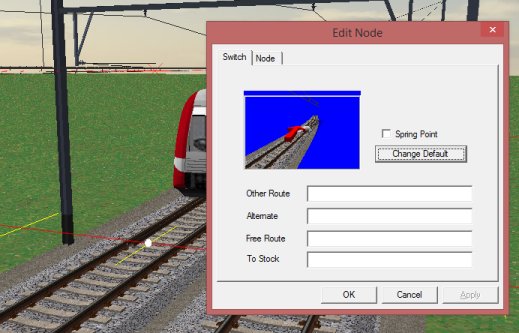|
|
|
Point Routing
Rail3D allows you to control the way trains travel through points by adding expressions to the point routing control.
- Double click a point/switch node: the switch dialog should open:

- Change Default - The red arrow shown is the "Default Route", that trains will normally take. The white arrow indicates the "Other Route". As you might guess, pressing this button swaps the two.
-
Spring Point - Is just a visual change to the way points render Usually a set of points will only change when a route is set over them, but if "Spring Point" is ticked, the points will return to the normal position after each train. (not currently implemented)
The four boxes below then allow you to choose how trains are routed:
- Other Route - Trains matching this will take the "Other Route" (white arrow).
- Alternate - Trains matching this will alternate between the two routes, e.g. the first train goes along the normal route, the second the other route, the third the normal etc.
- Free Route - Trains will take whichever route has no train occupying it, choosing randomly if both are free (or so it says - for some reason, I thought that it preferred the Default Route if both were free).
- To Stock - Trains will take whichever route leads to stabled stock that can be coupled to.
For the latter two options, the most common use is at a terminal station with loco-hauled trains. The terminating train will be routed as "Free Route", and will be sent to an empty platform. The engine then uncouples and runs round, and to return to its coaches, the engine will be routed as "To Stock" (in conjunction with a Shunt feature). With all text boxes on features (points, stops, uncouples), the ability to match trains is quite powerful. You can:
- Match one ID or multiple IDs. "1D00, 1G55, 2C30" will match those three IDs.
- Match all IDs matching a wildcard. "1D*" will match any ID beginning with 1D, e.g. 1D00, 1D02, 1D60, 1D102. "1D0?" will match one or zero characters in place of the question mark, e.g. 1D02, 1D04, but not 1D60 or 1D102. And just "*" will match everything.
- Match various features of the train with special expressions, surrounded in curly brackets {}. The types available are:
- "{type=37/0}" will match a train where the leading vehicle is "37/0".
- "{len>5}" will match any train with more than 5 vehicles ("l" and "length" also work). You can also use {len< and {len=
- "{rev=1}" or "{fwd=0}" matches trains where the driving vehicle is reverse. "{rev=0}" or "{fwd=1}" matches non-reverse vehicles, as does
- "{loco=1}", "{tender=1}" match if the loco or tender is leading.
- {route=""} is the equivalent of the plain ID matching.
- These options can be combined in a single expression. "{(len>5) & (route="1D*")}" will match any train beginning with 1D and more than 5 vehicles. The operators available are the standard boolean ones: "< > = != & |"
Examples

- Default Route is straight on
- Trains with route "FRT" take the right hand route

- Default route is straight on
- Trains of length 2 go the other way - to the left. Note, that a multiple unit created as a unit will count as 1, so "Len=2" applies to a pair of units as well as to a loco with one coach.
- Trains on Route "2200" will alternate routes.

Typical in a yard
- Trains with len>1 - ie a loco with a train go into any available freee route
- Trains with len=1 ie locos on their own, route to stabled stock that they can couple to
MRG 25/09/2014 15:55:19
|